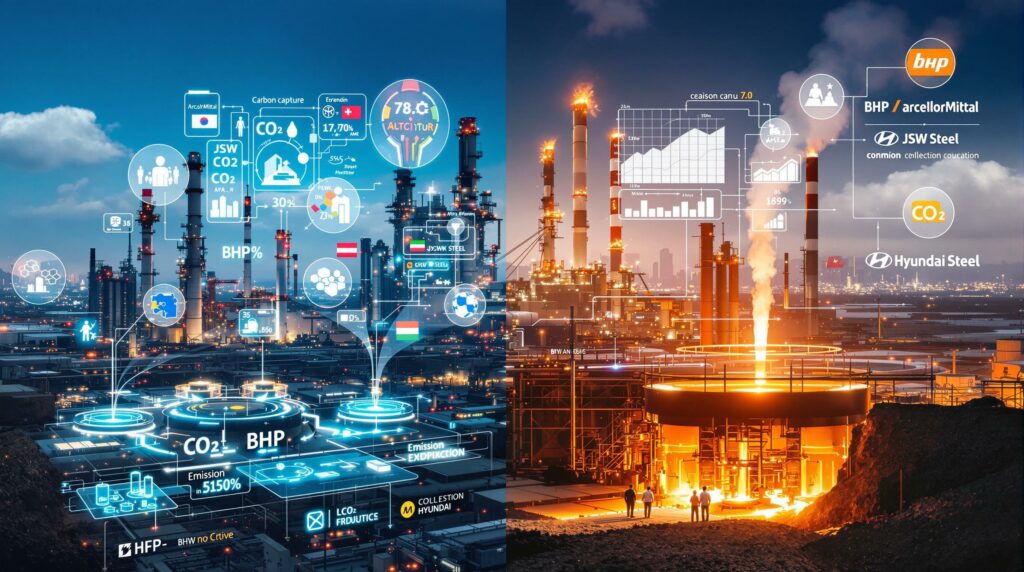BHP and Global Steelmakers Collaborate on Asian Carbon Capture Initiatives
As climate change pressures mount, a groundbreaking consortium led by BHP has emerged to tackle one of industry's most challenging emission sources. This initiative brings together major steel producers and energy companies in a collaborative effort to explore carbon capture solutions across Asian markets, potentially transforming how the steel industry addresses its substantial carbon footprint.
What is the BHP-led Carbon Capture Consortium?
Consortium Composition and Leadership
BHP, the world's largest mining company, is spearheading a multinational partnership focused on carbon capture solutions for hard-to-abate sectors. The initiative brings together key steel industry participants including ArcelorMittal Nippon Steel India, JSW Steel, and Hyundai Steel, creating an unprecedented alliance of major producers.
Energy sector giants Chevron Corporation and Mitsui & Co bring additional expertise to the collaboration, creating a cross-industry approach that spans the entire value chain from resource extraction through steel production. Project management responsibilities have been assigned to engineering firm Hatch, providing technical oversight for the complex initiative.
"By leveraging shared knowledge and resources with our partners, we are investing in support for innovative solutions, like the potential of CCUS, that we see as an essential part of decarbonizing hard-to-abate sectors such as steelmaking," explains Ben Ellis, BHP's vice president of marketing sustainability.
Strategic Timeline and Objectives
The consortium has established a structured timeline beginning with a one-year pre-feasibility study launching in 2025. This comprehensive assessment will explore deployment potential for carbon capture, utilization and storage (CCUS) technologies across multiple Asian markets.
Study findings are scheduled for public release by the end of 2026, providing transparency to industry stakeholders and potentially accelerating broader adoption. The strategic focus centers specifically on "hard-to-abate" industrial sectors, with steelmaking identified as the primary target due to its significant emissions profile and technical challenges.
The initiative represents a BHP strategy shift from individual company approaches to collaborative solutions, recognizing that the scale and complexity of industrial decarbonization requires coordinated action across corporate boundaries.
Why is Carbon Capture Critical for the Steel Industry?
Steel Production's Environmental Challenges
Steel manufacturing presents one of the most formidable decarbonization challenges in the industrial landscape. The fundamental production processes, particularly in blast furnace operations, rely heavily on coal and coke as both heat sources and reduction agents in ironmaking.
This dependence creates substantial carbon emissions that are intrinsic to current production methods rather than simply a function of energy inputs. While the industry has implemented significant efficiency improvements, these incremental approaches cannot achieve the deep decarbonization required to meet climate targets.
The industry faces mounting regulatory pressure across multiple markets, with carbon pricing mechanisms, emission caps, and climate disclosure requirements creating financial incentives for transformation. Border carbon adjustment mechanisms like the EU's CBAM further extend these pressures to global producers exporting to regulated markets.
Industry Context: Traditional steel production typically generates 1.8-2.0 tons of CO₂ for each ton of steel produced. The sector accounts for approximately 7-9% of global greenhouse gas emissions, making it a critical focus area for climate action.
Alternative production methods using green hydrogen show promise but face significant challenges, including:
- Substantially higher production costs (currently 2-3× traditional methods)
- Limited green hydrogen availability at industrial scale
- Massive infrastructure investment requirements
- Need for renewable electricity capacity expansion
CCUS Technology Status
Carbon capture technologies have reached relative maturity in terms of technical capability, with multiple commercial-scale operations demonstrating viability in related industrial applications. Post-combustion capture systems can achieve 90%+ capture rates, though implementation costs remain a significant barrier.
The core challenge across Asian markets isn't technological feasibility but rather economic viability. Key hurdles include:
- High capital expenditure requirements for capture equipment
- Significant operational costs, particularly for energy-intensive capture processes
- Limited existing CO₂ transport infrastructure in most regions
- Underdeveloped regulatory frameworks for storage site permitting and monitoring
- Absence of sufficient carbon pricing to create economic incentives
These challenges make collaborative approaches particularly valuable, as shared infrastructure and risk distribution can significantly improve project economics while creating sufficient scale for viable operations.
How Will the Consortium Approach Carbon Capture Implementation?
Shared Infrastructure Strategy
The partnership will assess how collaborative infrastructure development can dramatically reduce individual company costs through economies of scale. By pooling resources, the consortium can enable larger-scale projects than what any single company could economically undertake alone.
This collaborative approach provides several key advantages:
- Risk distribution across multiple organizations improves project viability by reducing individual company exposure
- Volume aggregation of captured carbon dioxide can reach critical thresholds necessary for economical storage or reuse applications
- Expertise sharing accelerates learning and implementation timelines
- Purchasing power increases through consolidated equipment and service procurement
- Standardization opportunities emerge across multiple facilities
The strategy recognizes that while individual facilities may not generate sufficient CO₂ volume to justify dedicated transport and storage infrastructure, aggregated volumes across multiple production sites can achieve viability thresholds.
Geographic Focus and Market Analysis
The study specifically targets opportunities across multiple Asian markets, where steel production has seen its most significant growth. The regional assessment will evaluate several critical factors:
- Geological storage potential, including depleted oil and gas reservoirs, saline aquifers, and other subsurface formations
- Industrial reuse applications, from enhanced oil recovery to chemical feedstock production
- Existing pipeline and transport infrastructure that could be repurposed for carbon management
- Market-specific regulatory environments and policy support mechanisms
- Regional industrial clustering opportunities for shared infrastructure
This comprehensive geographic analysis will identify optimal hub locations where multiple emission sources can connect to shared carbon management infrastructure, maximizing efficiency while minimizing capital requirements.
What Makes This Initiative Significant for Decarbonization Efforts?
Industry-Led Approach to Emissions Reduction
The consortium represents a private-sector driven approach to climate challenges, demonstrating how industry leadership can accelerate sustainability transformation without waiting for comprehensive policy frameworks. This proactive stance positions the participating companies at the forefront of industrial climate action.
The cross-industry collaboration bridges mining, steel production, and energy sectors, creating synergies that wouldn't be possible through isolated sectoral approaches. This integration across the value chain allows for system-level optimization rather than suboptimal point solutions.
The initiative demonstrates corporate recognition of decarbonization imperatives not just as regulatory compliance issues but as fundamental business sustainability challenges. For steel producers in particular, developing viable decarbonization pathways represents an existential priority as markets increasingly demand lower-carbon materials.
Market Perspective: Forward-looking steel producers recognize that maintaining market access increasingly depends on demonstrating credible emission reduction strategies, particularly for premium automotive, construction, and consumer goods applications.
Potential Climate Impact
Steel production accounts for approximately 7-9% of global carbon emissions, making it one of the largest industrial contributors to climate change. Successful CCUS implementation across the sector could significantly reduce this environmental burden, particularly in regions where alternative production methods face economic or resource constraints.
The initiative addresses a critical gap in industrial decarbonization strategies by focusing on capturing emissions from existing assets rather than requiring complete facility replacement. This approach provides a transitional pathway that can deliver significant near-term reductions while longer-term solutions mature.
The regional focus on Asia targets some of the world's largest steel producing nations, where production capacity continues to grow. As the global center of steel manufacturing, Asian decarbonization efforts will have disproportionate impact on the sector's overall emissions trajectory.
What Challenges Must the Consortium Overcome?
Economic and Financial Hurdles
Carbon capture technologies currently face challenging cost-benefit equations, with typical capture costs ranging from $50-100 per ton of CO₂ depending on the specific application and scale. When transportation and storage costs are added, total expenses can reach $70-150 per ton—exceeding current carbon prices in most markets.
Initial capital expenditure requirements remain prohibitively high for many companies, with large-scale installations typically requiring hundreds of millions in investment before capturing a single ton of carbon. This significant upfront cost creates financing challenges, particularly in markets with higher capital costs.
Operational expenses, especially increased energy consumption for capture processes, can impact competitiveness without supportive carbon pricing or other incentive mechanisms. Energy penalties of 15-30% create ongoing cost disadvantages compared to unabated production.
Return on investment timelines may extend beyond traditional corporate planning horizons, creating tension with quarterly performance pressures and competing capital allocation priorities. These extended payback periods require innovative financing approaches and strong strategic commitment.
Technical and Regulatory Barriers
Storage capacity assessment requires extensive geological surveys to ensure sufficient capacity and containment integrity. This technical groundwork demands significant time and investment before project commitments can be finalized.
Transportation infrastructure for captured carbon remains underdeveloped across most Asian markets, requiring new pipeline networks or other transport solutions to connect capture sites with storage locations. These infrastructure gaps create additional coordination challenges across multiple stakeholders.
Regulatory frameworks for carbon storage vary significantly across Asian markets, with many jurisdictions lacking clear permitting pathways, monitoring requirements, or liability provisions. This regulatory uncertainty increases project risk and can extend development timelines.
Permitting processes for new carbon storage facilities can be lengthy and complex, involving multiple regulatory bodies and extensive public consultation. Streamlined approval pathways will be essential for timely project implementation.
What Role Does BHP Play in Decarbonization Leadership?
BHP's Strategic Position
As the world's largest mining company, BHP has significant influence on resource sector practices and broader industry evolution trends. This scale creates both responsibility and opportunity to drive systemic change beyond the company's direct operations.
The company supplies essential raw materials to the steel industry, creating supply chain leverage that can influence customer decarbonization efforts. This upstream position allows BHP to support transformation across the entire value chain rather than focusing solely on its own emissions.
BHP has established sustainability commitments that extend to its customer industries, recognizing that Scope 3 emissions—those generated by the use of sold products—represent its most significant climate impact. Supporting customer decarbonization becomes a strategic priority within this framework.
The company's scale enables it to coordinate large multi-stakeholder initiatives that smaller organizations couldn't effectively manage. This convening power allows BHP to align diverse industry players around shared challenges, pooling resources and expertise for greater impact.
Executive Perspective
Ben Ellis, BHP's vice president of marketing sustainability, emphasizes the importance of collaborative solutions to industrial decarbonization challenges. "By leveraging shared knowledge and resources with our partners, we are investing in support for innovative solutions, like the potential of CCUS, that we see as an essential part of decarbonizing hard-to-abate sectors such as steelmaking," Ellis explains.
BHP views CCUS as "an essential part of decarbonizing hard-to-abate sectors such as steelmaking," positioning the technology as a critical component of its broader sustainability strategy. This perspective acknowledges that while multiple decarbonization pathways exist, carbon capture provides a necessary transition tool for existing assets.
The company is strategically investing in innovative approaches to emissions reduction, recognizing that portfolio diversification across multiple technologies hedges against uncertain technology pathways. This approach balances near-term pragmatism with longer-term transformation vision.
Knowledge and resource sharing form core principles of BHP's sustainability strategy, reflecting the understanding that industrial decarbonization requires collective action rather than competitive approaches. This collaborative mindset underpins the consortium's formation and ongoing work.
FAQ: Carbon Capture in Steel Production
What is carbon capture, utilization and storage (CCUS)?
CCUS encompasses technologies that capture CO₂ emissions from industrial processes, then either utilize the carbon in other applications or permanently store it underground to prevent atmospheric release. The process typically involves three distinct stages:
- Capture: Separating CO₂ from other gases in industrial exhaust streams
- Transportation: Moving captured CO₂ via pipeline, ship, or other means to utilization or storage sites
- Utilization/Storage: Either using the CO₂ in commercial applications or injecting it into suitable geological formations for permanent sequestration
Different capture technologies exist for various applications, including post-combustion capture (most relevant for existing steel plants), pre-combustion capture, and oxyfuel combustion. Each offers different efficiency and cost profiles depending on the specific industrial context.
Why is the steel industry particularly difficult to decarbonize?
Steel production traditionally relies on coal-based blast furnaces that generate significant CO₂ as part of the chemical reduction process. This creates emissions that are inherent to the production chemistry rather than simply related to energy use.
The reduction process (removing oxygen from iron ore) requires either carbon or hydrogen as reducing agents. With current technology and economics, carbon-based reduction remains dominant globally, with coal serving dual roles as heat source and reducing agent.
Alternative production methods using hydrogen or electricity remain economically challenging at industrial scale, with cost premiums of 30-80% compared to conventional production. The capital-intensive nature of steel production also means that existing assets have multi-decade operational lifespans, creating transition challenges.
The high temperatures required for steelmaking (>1500°C) limit electrification options for many process stages, further complicating decarbonization efforts compared to industries with lower temperature requirements.
How does carbon capture differ from other decarbonization approaches?
While many decarbonization strategies focus on preventing emissions through alternative energy sources or processes, carbon capture addresses emissions that cannot be eliminated through other means, making it particularly valuable for hard-to-abate sectors.
This "end-of-pipe" approach offers several distinct advantages:
- Compatibility with existing assets: CCUS can be retrofitted to operational facilities, protecting existing investments
- Immediate applicability: Implementation doesn't require fundamental process changes or new technologies
- Incremental deployment: Capture can be applied to specific process streams initially, then expanded
- Complementary integration: CCUS can work alongside other decarbonization approaches like efficiency improvements
This retrofitting capability makes carbon sequestration tech particularly valuable as a transitional technology that can deliver near-term emission reductions while longer-term transformation pathways mature.
What potential uses exist for captured carbon dioxide?
Captured CO₂ can be utilized in various applications, creating potential value streams from what would otherwise be waste emissions:
- Enhanced oil recovery (EOR): Injecting CO₂ into oil reservoirs to increase production while storing carbon
- Building materials: Incorporating CO₂ into concrete curing processes, creating stronger products while sequestering carbon
- Synthetic fuels: Combining CO₂ with hydrogen to create hydrocarbon fuels with lower lifecycle emissions
- Food and beverage industry: Using food-grade CO₂ for carbonation and preservation applications
- Chemical manufacturing: Producing carbonates, polymers, and other carbon-based chemical products
- Greenhouse agriculture: Enhancing plant growth through controlled CO₂ enrichment
These utilization pathways can improve project economics by generating revenue from captured carbon, though storage capacity limitations mean that geological sequestration remains necessary for climate-significant volumes.
The Future of Carbon Capture in Asian Steel Production
Potential Regional Impact
Asia represents approximately 70% of global steel production, with China alone accounting for over half of worldwide output. This concentration makes the region central to any meaningful decarbonization strategy for the sector, with disproportionate climate impact potential.
Successful implementation could create significant emissions reductions across the region, particularly if initial projects demonstrate commercial viability and create replicable models. Early estimates suggest that comprehensive CCUS implementation could reduce Asian steel sector emissions by 20-40% while alternative production methods mature.
Regional hubs could enable smaller producers to access carbon capture infrastructure that would be economically unfeasible on an individual facility basis. This "hub and cluster" approach allows participation across diverse company sizes and types, maximizing sectoral coverage.
Cross-border collaboration may accelerate technology deployment and standardization, creating economies of scale and learning effects that improve economics over time. The multinational composition of the BHP-led global steelmakers group provides a foundation for this regional integration.
Long-term Industry Transformation
Carbon capture represents one component of a broader steel industry transition that will likely include multiple complementary approaches. While CCUS offers near-term emission reductions for existing assets, comprehensive decarbonization will require process transformations, particularly hydrogen-based reduction.
Integration with other technologies like hydrogen reduction will likely be necessary to achieve the deepest emission cuts, with hybrid approaches emerging as pragmatic pathways. These might include hydrogen injection into existing blast furnaces combined with partial CO₂ capture.
Successful pilots could accelerate wider adoption across the global steel sector by demonstrating technical feasibility, economic viability, and regulatory pathways. The industry has historically diffused innovations relatively slowly, but climate pressures may accelerate adoption curves.
Industry knowledge sharing through initiatives like the Asia Carbon Consortium may accelerate decarbonization timelines by reducing duplication of effort and fostering collaborative problem-solving. This structured cooperation represents a shift from traditional competitive industry dynamics toward shared climate challenges.
Furthermore, the integration of renewable energy transitions will be crucial for maximizing the climate benefits of carbon capture technologies, ensuring that the energy used in capture processes doesn't simply shift emissions elsewhere
Looking to Profit from Major Mineral Discoveries?
Discover how major ASX mineral discoveries can lead to significant investment returns by exploring Discovery Alert's dedicated discoveries page, where the proprietary Discovery IQ model delivers real-time notifications on high-potential opportunities before the broader market reacts. Begin your 30-day free trial today at https://discoveryalert.com.au/discoveries/ to gain immediate access to AI-powered trade alerts that transform complex mineral data into actionable investment insights.




